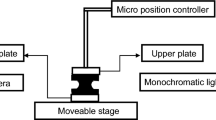Abstract
Latex paints contain several types of particles including polymer binder, primary pigment, extenders, and colorants. When the paints contain associative thickeners, control of particle dispersion can be very complicated due to the interaction of the particles with dispersants, surfactants, and the associative thickener itself. In particular, dispersion of the pigments can act independently of dispersion of the binder particles. The consequences of this situation are manifested in the physical properties of the paint and of the films it forms. This paper describes these interactions in terms of their colloid chemistry and shows the consequences of additive choices on the particle dispersion and also the optical properties of model paint films.






















Similar content being viewed by others
References
Glass JE (2001) A Perspective on the History of and Current Research in Surfactant-Modified, Water-Soluble Polymers J. Coat. Technol., 73 913, 79
Kostansek E (2003) Using Dispersion/Flocculation Phase Diagrams to Visualize Interactions of Associative Polymers, Latexes and Surfactants J. Coat. Technol., 75,940, 27
Kostansek E (2005) Associative Polymer/Latex Dispersion Phase Diagrams II: HASE Thickeners J. Coat. Technol. Res., 2, 6, 1
Sperry, PR, Thibeault, JT, Kostansek, EC, “Flocculation and Rheological Characteristics of Mixtures of Latexes and Water-Soluble Polymeric Thickeners.” Adv. Org. Coat. Sci. Technol., Series 9 (1) (1987)
Thibeault, JT, Sperry, PR, Schaller, EJ. “Effect of Surfactants and Cosolvents on the Behavior of Associative Thickeners in Latex Systems,” In: Glass, JE (ed.) Water Soluble Polymers: Beauty with Performance, Advances in Chemistry Series 213, Chapter 20. American Chemical Society, Washington, D.C. (1986)
Sperry, PR, “A Simple Quantitative Model for the Volume Restriction Flocculation of Latex by Water-Soluble Polymers.” J. Colloid Interface Sci., 87 375 (1982); Sperry, PR, “Morphology and Mechanism in Latex Flocculated by Volume Restriction,” J. Colloid Interface Sci., 99 97 (1984)
Myers D (1999) Surfaces, Interfaces, and Colloids, 2nd edn. Wiley-VCH, New York
Kostansek E (2004) Controlled Coagulation of Emulsion Polymers J. Coat. Technol. Res., 1, 1, 41
Kostansek E (2006) Associative Polymer/Particle Dispersion Phase Diagrams III: Pigments J. Coat. Technol. Res. 3, 3, 165
Lundberg DJ, Glass JE (1992) Pigment Stabilization Through Mixed Associative Thickener Interactions J. Coat. Technol., 64, 807, 53
Tarng, M-R, et al., “Associative Thickeners in the Land of Commercial Reality: Coating Formulations,” In: Glass, JE (ed.) Hydrophilic Polymers: Performance with Environmental Acceptability, Advances in Chemistry Series 248, Chapter 24. American Chemical Society, Washington, D.C. (1996)
Svanholm T, Kronberg B, Molenaar F (1997) Adsorption Studies of Associative Interactions between Thickener and Pigment Particles Prog. Org. Coat. 30, 167
Glass JE (1999) Adsorption of HEUR Thickeners on Latex and Titanium Dioxide Disperse Phases Adv. Colloid Interface Sci. 79, 123
Melville I et al (1987) Pigment Thickener Interactions in Emulsion Paints Polym. Paint Colour J. 177(4187) 174
Johnson EA (1994) Interactions Between Rheology-Modifying and Pigment-Dispersing Agents Farbe & Lack, 100 (9), 759
Bergh JS, Lundberg DJ, Glass JE (1989) Rheology of Associative Thickener Pigment and Pigmented Commercial Latex Dispersions Prog. Org. Coat., 17, 155
Mahli DM, Wegner JM, Glass JE, Phillips DG (2005) Waterborne Latex Coatings of Color: I J. Coat. Technol. Res., 2, 8, 627
Mahli DM, Wegner JM, Glass JE, Phillips DG (2005) Waterborne Latex Coatings of Color: II J. Coat. Technol. Res., 2, 8, 635
Reiman H et al (2002) Particles in Networks (“Partikel in Netzwerken”) Farbe & Lack 108, 91
Acknowledgment
The author would like to thank the Rohm and Haas Co. for support and for permission to publish this work.
Author information
Authors and Affiliations
Corresponding author
Rights and permissions
About this article
Cite this article
Kostansek, E. Controlling particle dispersion in latex paints containing associative thickeners. J Coat Technol Res 4, 375–388 (2007). https://doi.org/10.1007/s11998-007-9037-9
Published:
Issue Date:
DOI: https://doi.org/10.1007/s11998-007-9037-9




